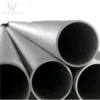HXSCO Stainless steel composite panels
Stainless steel composite panels are multi-layer materials made by bonding stainless steel to other metal substrates such as carbon steel, low-alloy steel, or aluminum. They have both the corrosion resistance and aesthetics of stainless steel and the high strength, toughness, and cost-effectiveness of the substrate. This versatile material has excellent performance and cost-effectiveness, making it an ideal choice for various industrial and architectural applications.
HXSCO is a professional stainless steel composite panel supplier. We have advanced technology and rich industry expertise, and are committed to providing high-quality stainless steel composite panels. We provide global customers with tailored innovative metal solutions to meet various application needs.
Specification of Stainless steel composite panels
| Specification | Details |
|---|---|
| Thickness | Total: 5-50mm (cladding material: 1-10mm) |
| Width | Up to 2500mm |
| Length | Up to 15000mm |
| Surface Treatment | No.1 finish or customized as needed |
| Base Materials | ASTM A36, ASME SA516 Gr.60/65/70, ASME SA537 Gr.1/2/3, ASME SA105, ASME SA350 LF1/LF2/LF3, etc. |
| Cladding Materials | ASME SA240 TP304/304L, 316/316L, 321/321H, 347/347H, S31803, S32205, S32760, 904L, etc. |
| Composite Process | Explosive Bonding, Hot Bonding, Cold Bonding |
| Manufacturing Standards | ASME SA264, JIS G 3601, NB/T47002.1, YB/T4282 |
Types of Stainless Steel Composite Plates
Stainless steel composite plates can be classified according to their manufacturing process, material combination, and application.
Classification by manufacturing process
- Explosive bonding
Use high-energy explosions to bond stainless steel and substrates together under high pressure. This composite plate has strong bonding. Suitable for heavy industries such as pressure vessels, chemical storage tanks and marine engineering.
- Hot-rolled cladding
Stainless steel and substrate are bonded by high temperature and high pressure in the rolling mill. The surface is smooth, and the overall consistency is good. Large-scale production is cost-effective and is often used in construction and decorative panels.
- Cold rolling or laser welding
Thin layers of stainless steel are bonded to the substrate using advanced cold rolling or laser technology. This composite plate is highly precise and suitable for lightweight applications and complex designs. It is widely used in high-end building facades or precision equipment.
Classification by material combination
- Stainless steel + carbon steel
Combines stainless steel’s corrosion resistance with carbon steel’s strength and economy. Very suitable for applications in chemical and power plants.
- Stainless steel + low alloy steel
Suitable for environments that require enhanced mechanical strength and structural support. Commonly used in bridges, pipelines, and large industrial components.
- Stainless steel + aluminum
Excellent corrosion resistance and electrical conductivity. Commonly used in aerospace and transportation industries.
Classification by application
- Structural composite panels
Used for load-bearing components, providing durability and stability.
- Decorative composite panels
Designed for architectural applications. Focus on aesthetics and surface treatment (such as brushed, polished or mirrored).
- Anti-corrosion composite panels
Suitable for harsh environments such as offshore platforms, chemical plants, and desalination equipment.
Performance and Advantages of Stainless Steel Composite Plates
Stainless steel composite plate is an engineering material. It combines the excellent performance of stainless steel with the structural advantages of base metals such as carbon steel, low-alloy steel, or aluminum.
1. Excellent corrosion resistance
The stainless steel surface has excellent rust, oxidation, and chemical corrosion resistance. It is very suitable for harsh environments such as chemical plants, marine structures, and desalination systems.
2. High strength-to-cost ratio
By bonding stainless steel with cost-effective base metals, stainless steel composite plates provide excellent mechanical strength and durability. Such materials cost only a fraction of solid stainless steel.
3. Lightweight and versatile
When combined with materials such as aluminum, these plates become light and strong. Suitable for applications that need to reduce weight, such as transportation and aerospace.
4. Customizable surface quality
The stainless steel layer can be surface treated with brushed, polished or mirrored to achieve the desired aesthetic and functional effects, which is very suitable for architectural and decorative purposes.
5. Advanced bonding technology
Modern manufacturing methods such as explosive bonding and hot rolling ensure seamless bonding between layers. This composite plate has consistent performance and long-lasting reliability.
Application of Stainless Steel Composite Plate
Stainless steel composite plate is a versatile material. It combines corrosion resistance, mechanical strength, and cost-effectiveness. Its adaptability makes it suitable for a wide range of industries and applications:
Chemical industry
Applications: storage tanks, heat exchangers, pressure vessels, and piping systems
Marine engineering
Applications: shipbuilding, offshore platforms, and desalination systems
Energy sector
Applications: boilers, condensers, flue gas desulfurization systems, and reactor components
Building and construction
Applications: building facades, decorative wall panels, elevators, and cladding materials
Transportation
Applications: lightweight structural components in automobiles, railways, and aerospace
Food and pharmaceutical industries
Applications: food processing, brewing, and pharmaceutical manufacturing equipment
Environmental protection
Applications: components in wastewater treatment and flue gas purification systems












